Risk management About … Risk Management Mouse ‘Click’


Risk management

About … Risk Management

Mouse ‘Click’ to move on to the next slide What is Risk Management? Who uses Risk Management?
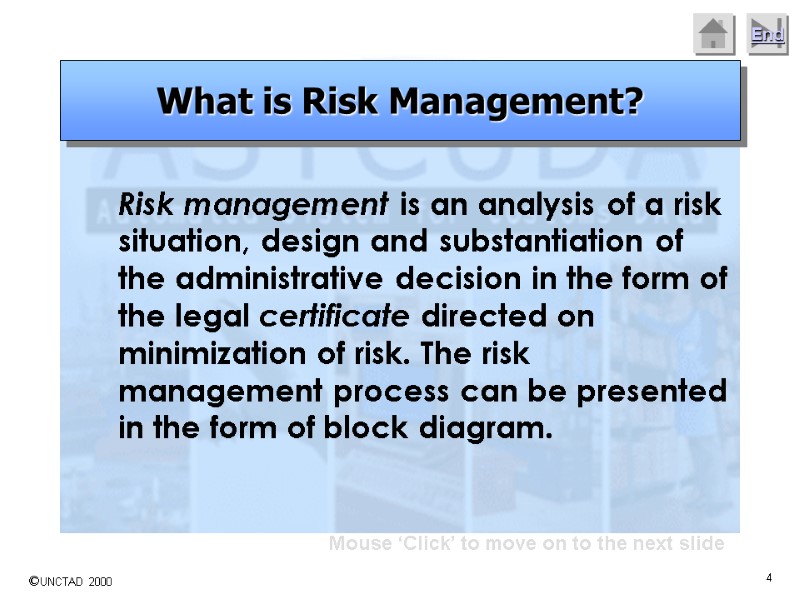
Mouse ‘Click’ to move on to the next slide Risk management is an analysis of a risk situation, design and substantiation of the administrative decision in the form of the legal certificate directed on minimization of risk. The risk management process can be presented in the form of block diagram. What is Risk Management?

Risk Management

Mouse ‘Click’ to move on to the next slide Next Risk Management is the name given to a logical and systematic method of identifying, analysing, treating and monitoring the risks involved in any activity or process. What is Risk Management?
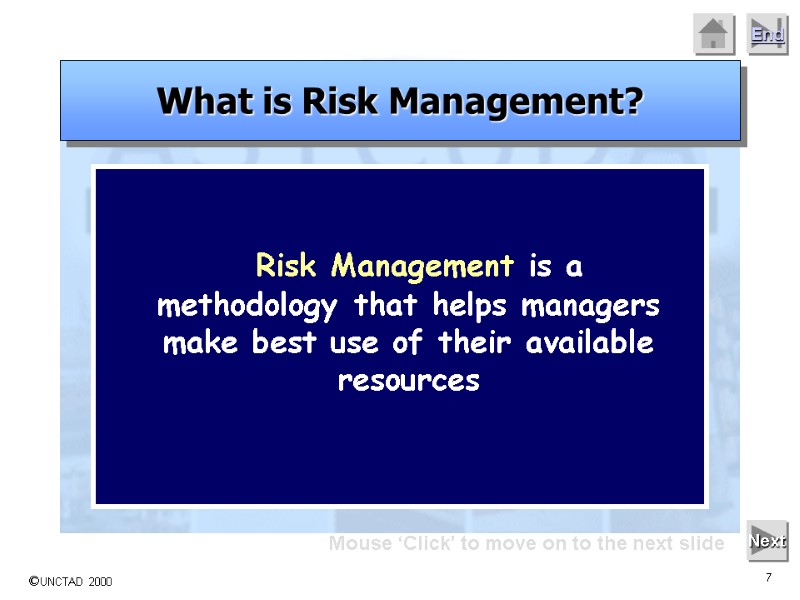
Mouse ‘Click’ to move on to the next slide Next Risk Management is a methodology that helps managers make best use of their available resources What is Risk Management?

Risk Management practices are widely used in public and the private sectors, covering a wide range of activities or operations. These include: Who uses Risk Management? Finance and Investment Insurance Health Care Public Institutions Governments

Effective Risk Management is a recognized and valued skill. Educational institutions have formal study courses and award degrees in Risk Management. The Risk Management process is well established. (International RM process standards.) Who uses Risk Management?

Risk Management is now an integral part of business planning. Who uses Risk Management?

. The basic process steps are: Establish the context Identify the risks Analyse the risks Evaluate the risks Treat the risks
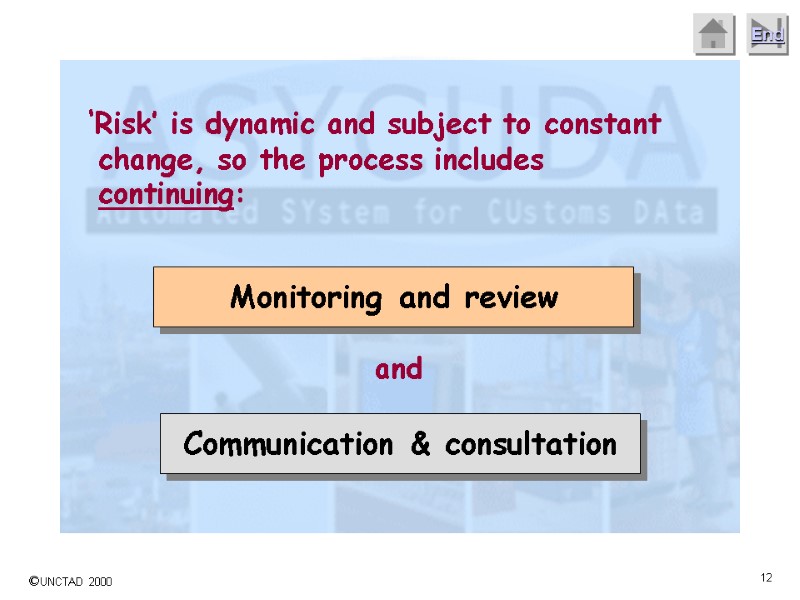
‘Risk’ is dynamic and subject to constant change, so the process includes continuing: Communication & consultation Monitoring and review and

The Risk Management process: The strategic and organizational context in which risk management will take place. For example, the nature of your business, the risks inherent in your business and your priorities. Communicate & consult Establish the context

The Risk Management process: Communicate & consult Monitor and review Defining types of risk, for example, ‘Physical: this could involve personal injuries, environmental and weather conditions and the physical assets of your organization ’. Identifying the stakeholders, (i.e., who is involved or affected). Past events, future developments. Identify the risks

The Risk Management process: Communicate & consult Monitor and review Analyse the risks How likely is the risk event to happen? (Probability and frequency?) What would be the impact, cost or consequences of that event occurring? (Economic, political, social?)

In analyzing a risk you are deciding on the relationship between the likelihood of a risk occurring and the consequences of the risk you have identified. You then have to define the level of risk: Extreme: An extreme risk requires immediate action as the potential could be devastating to the enterprise. High: A high level of risk requires action, as it has the potential to be damaging to the enterprise. Moderate: Allocate specific responsibility to a moderate risk and implement monitoring or response procedures. Low: Manage a low level of risk with routine procedures.

The Risk Management process: Communicate & consult Monitor and review Evaluate the risks In this step you are deciding whether a risk is acceptable. Your evaluation will take into account the following: • the importance of the activity you are risk managing and its outcomes • the degree of control you have over the risk

the potential and actual losses which may arise from the risk the benefits and opportunities presented by the risk The Risk Management process: Communicate & consult Monitor and review Evaluate the risks

The Risk Management process: Treat the risks Develop and implement a plan with specific counter-measures to address the identified risks. Consider: Priorities (Strategic and operational) Resources (human, financial and technical) Risk acceptance, (i.e., low risks)

The Risk Management process: Identifying options to treat the risk Selecting the best treatment option Preparing a risk treatment plan Implementing a risk treatment plan Communicate & consult Monitor and review Treat the risks

The options available to manage this risk are to: Avoid the risk by deciding not to process with the activity or choosing another way to achieve the same outcome. Control the risk by reducing the likelihood of the risk occurring, the consequences of the risk or both. Transfer the risk by shifting all or part of the responsibility of the risk to another party who is best able to control it. Retain the risk after accepting that the risk cannot be avoided, controlled to transferred The Risk Management process: Treat the risks

The Risk Management process: Communicate & consult Risk Management policies and decisions must be regularly reviewed. Monitor and review In identifying, prioritising and treating risks, organisations make assumptions and decisions based on situations that are subject to change, (e.g., the business environment, trading patterns, or government policies).

The Risk Management process: Risk Managers must monitor activities and processes to determine the accuracy of planning assumptions and the effectiveness of the measures taken to treat the risk. Methods can include data evaluation, audit, compliance measurement. Communicate & consult Monitor and review

The Risk Management process: Establish the context Identify the risks Analyse the risks Evaluate the risks Treat the risks Monitoring and review Communication & consultation

http://www.riskmanagement.qld.gov.au http://www.ourcommunity.com.au/insurance/insurance_main.jsp http://www.ozco.gov.au/arts_resources/other/risk_management_and_insurance_fo r_arts_enterprises/files/2131/risk_management%202004.pdf Resources

After establishing ‘Likelihood’ and ‘Consequence’ you can use a table like this to set a level of risk. Evaluate the risks You must define what these risk levels mean to you.
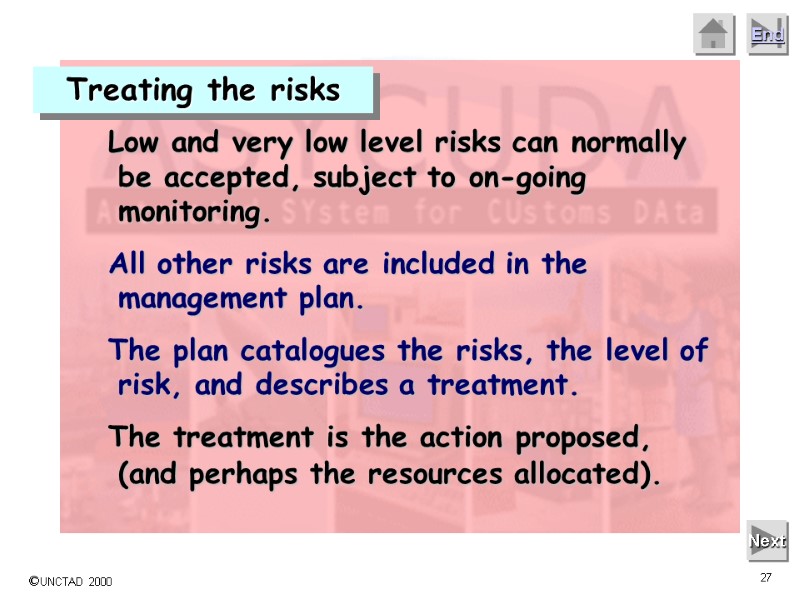
Next Low and very low level risks can normally be accepted, subject to on-going monitoring. All other risks are included in the management plan. The plan catalogues the risks, the level of risk, and describes a treatment. The treatment is the action proposed, (and perhaps the resources allocated). Treating the risks
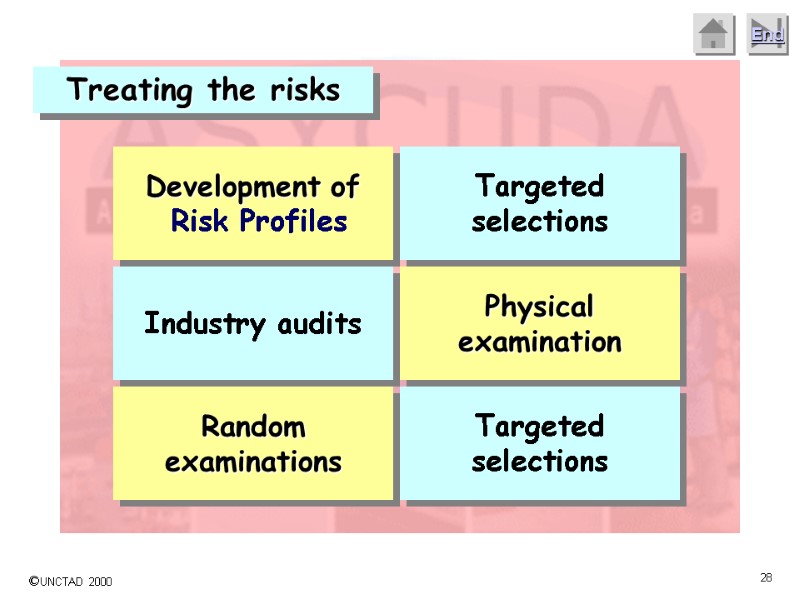
Treating the risks Targeted selections Development of Risk Profiles Physical examination Industry audits Random examinations Targeted selections
1080-risk_management.ppt
- Количество слайдов: 28

